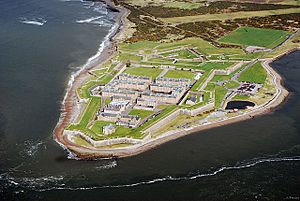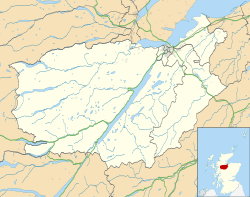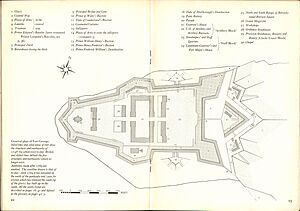Fort George, Highland facts for kids
Quick facts for kids Fort George |
|
|---|---|
| Ardersier, Highland, Scotland | |

Fort George from the air
|
|
|
Location within Inverness-shire
|
|
| Coordinates | 57°35′02″N 4°04′13″W / 57.58389°N 4.07028°W |
| Type | Georgian Bastion fort |
| Height | Up to 12 metres (39 ft) |
| Site information | |
| Owner | Ministry of Defence |
| Operator | |
| Site history | |
| Built | 1748–1769 |
| Built for | War Office |
| In use | 1757-Present |
| Materials | Sandstone |
| Events | Built after the Jacobite rising of 1745 |
| Garrison information | |
| Occupants | The Black Watch, 3rd Battalion The Royal Regiment of Scotland |
Fort George is a huge 18th-century fortress in Scotland. It's located near Ardersier, not far from Inverness. This amazing fort was built to help control the Scottish Highlands. It was created after a big rebellion called the Jacobite rising of 1745.
The fort is designed like a star, which was a very clever way to build defenses back then. It looks almost exactly as it did when it was finished. Today, Fort George is still used by the army. But it's also a popular place for visitors to explore. You can see exhibits that show what life was like for soldiers long ago.
Contents
The First Fort George
Before the current Fort George, there was an older one in Inverness. This first fort was finished in 1726. General George Wade ordered its construction. It stood on a hill next to the River Ness.
This old fort used parts of a much older castle. That castle was started by Malcolm III of Scotland way back in the 11th century. In the 1600s, Oliver Cromwell made the castle even stronger. But by the 1700s, it was no longer used.
General Wade's Fort George could hold 400 soldiers. Its first commander was Sir Robert Munro, 6th Baronet. He was a colonel in the famous Black Watch regiment.
Old Fort George Under Attack
During the 1745 rebellion, about three thousand Jacobite rebels attacked the fort. They surrounded it, and no help could reach the soldiers inside. Fort George had to surrender in February 1746. The Jacobites then blew up the fort. They did this to stop the British Army from using it again.
After the British won the Battle of Culloden in 1746, they decided to build a new fort. Colonel William Skinner was put in charge. They chose a new spot, about 10 miles (16 km) from Inverness. This new location was at the mouth of the Moray Firth. The old fort's site was empty for nearly 70 years. Later, a new building called Inverness Castle was built there. It looked like a castle but was used as a prison and courthouse.
Building the New Fort George
The perfect spot for the new fort was a flat piece of land at Ardersier. It sticks out into the Moray Firth. This location was great because it could control ships coming into Inverness. The fort also had its own harbor. This meant supplies could arrive by sea, even if the fort was under attack.
Work on Fort George started in 1748. Colonel Skinner led the project. Famous architects, the Adam brothers (John, Robert, and James), were the main builders. About 1,000 soldiers helped with the hard work. They also protected the site from any attacks.
By 1757, the main defenses were mostly finished. Fort George was finally completed in 1769. It was a huge project. The original plan was to spend about £92,000. But the final cost was more than £200,000. That was an enormous amount of money at the time!
How Fort George Was Defended
Fort George is a great example of strong defenses. Its main walls are made of stone. They are shaped with many angles and points. These points have bastions and redoubts that stick out. This design meant that guns on one wall could fire at attackers trying to reach another wall.
The walls are very wide and covered with grass. Underneath are strong, arched rooms called casemates. These are like underground bunkers. They were built to protect all the soldiers from enemy cannon fire. The land leading up to the fort is covered in loose stones. This made it hard for attackers to move quickly.
The fort is almost hidden by sloping grassy banks. These banks were designed to absorb cannonball impacts. To get inside, you first cross a ravelin. This is a separate defensive building with a guardhouse. It's completely open to fire from the main fort. Then, you cross a raised wooden walkway with a drawbridge. This bridge goes over a wide ditch. The ditch is between heavily defended walls. This open ditch was a dangerous "killing ground" for any attackers.
Fort George in Action
Over the years, many famous Scottish regiments have been based at Fort George. In 1881, the 72nd and 78th Regiments joined to become the Seaforth Highlanders. Their main base was at the fort. Later, in 1961, they joined with the Queen's Own Cameron Highlanders. They formed a new regiment called the Queen's Own Highlanders (Seaforth and Camerons). Fort George became their home too. Since 2007, the fort has been home to the Black Watch, which is the 3rd Battalion, Royal Regiment of Scotland.
In 2016, the Ministry of Defence announced that Fort George was planned to close in 2032. This was later delayed to 2033. The Defence Minister, Sir Michael Fallon, said the fort was no longer needed. He joked that the Highland rebellions were over!
Visiting Fort George
Fort George is still an active military base. But a large part of it is open to the public. There is an entrance fee to visit. Historic Environment Scotland has displays in one of the barracks. These shows what life was like for soldiers when the fort was new.
The Grand Magazine building has a collection of old weapons. Actors also bring history to life there. They tell stories of soldiers from the 18th century. In 2019, over 76,000 people visited the fort.
Highlanders' Museum
The old Lieutenant Governors’ House is now home to the Highlanders' Museum. This is the official museum for the Queen's Own Highlanders and Lovat Scouts. Inside, you can see many interesting things. There are old uniforms, weapons, and medals. You can also see "death pennies," which are memorial plaques from World War I.
The museum has photos, paintings, and other items from the regiments. It tells the story of these regiments and their links to Scottish clans. You can learn about famous soldiers and their actions in different wars. The fort's chapel is also open to visitors. It has many regimental flags and memorials.
Images for kids
-
Bartizan turrets guard the scarp (dry moat) for defence in depth
-
The sole surviving example of a MK1 RML 64 pounder 64 cwt gun is housed at the fort
-
The 18th-century chapel's interior has a two-tiered arcade on three sides supported by Roman Doric columns
-
A 13-inch smooth bore mortar could fire – at a fixed angle of 45 degrees – a shell weighing 200 lb (91 kg) up to 2,900 yd (2,700 m) using 9 lb (4.1 kg) of black powder
See also
- Armed forces in Scotland
- Military history of Scotland














